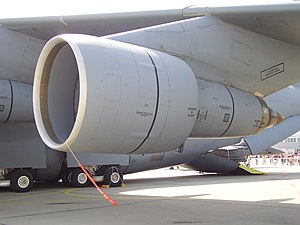| TF39 | |
|---|---|
| A TF39 on a C-5 Galaxy at ILA (Internationale LuftfahrtAusstellung) in Berlin, 2008 |
The General Electric TF39 is a high-bypass turbofan engine. Developed to power the Lockheed C-5 Galaxy, it was the first high-power, high-bypass jet engine available. The TF39 was developed into the CF6 series of engines, and formed the basis of the General Electric LM2500 marine and industrial gas turbine. In late 2017, after a C-5 plane with TF-39 engines made its last flight, the TF-39 was formally retired, thus making all remaining C-5s being converted to Super Galaxies with CF6 engines.
Development
The United States Air Force opened the "CX-X Program" in 1964, intending to produce a next-generation strategic airlifter. Of the several airfrrame and engine proposals returned for consideration, Lockheed's aircraft and General Electric's engine were selected for the new design in 1965.
The high-bypass turbofan was a huge leap in engine performance, offering a thrust of 43,000 pounds, while improving fuel efficiency by about 25%.[1] The TF39 had an 8-to-1 bypass ratio, 25-to-1 compressor pressure ratio, a 2,500 °F (1,370 °C) turbine temperature made possible by advanced forced-air cooling. The first engine went for testing in 1965. Between 1968 and 1971, 463 TF39-1 and -1A engines were produced and delivered to power the C-5A fleet.
Design

TF39s on a C-5 Galaxy, from the rear
The TF39 is a revolutionary 1960s engine rated from 41,000 to 43,000 lbf (191 to 205 kN) of thrust. It employed a great deal of then-new technological features such as:
- 1½ stage fan blades (unique to TF39).
- 8:1 bypass ratio.
- Variable stator vanes.
- Turbines equipped with advanced cooling.
- Fuel efficiency better than any engines available at the time.
- Cascade-type thrust reversers.
Mechanically, the TF39 is rather unusual for a high bypass ratio turbofan; the single stage is snubbered ('Snubbers' are protuberances that stick-out at right angles to the fan aerofoil somewhere between mid-span and blade tip). The snubbers on adjacent fan blades butt-up against each other, in a peripheral sense and improve the vibration characteristics of the blade to the fan rotor which has a set of inlet guide vanes for the outer bypass section and the core booster stage located in front of the fan rotor, rather than behind. This unique design is clearly seen from the front.[2][3]
Applications
- Lockheed C-5A/B/C Galaxy
Specifications (TF39-1C)
Data from [4]
- General characteristics
- Type: Turbofan
- Length: 312 in (792 cm)
- Diameter: 97 in (246 cm)
- Dry weight: 8000 lb (3630 kg)
- Components
- Compressor: Axial, 1 stage fan, 5 stage low pressure compressor, 16 stage high pressure compressor
- Combustors: Annular
- Turbine: Axial, 2 stage high pressure turbine, 6 stage low pressure turbine.
- Performance
- Maximum thrust: 43,300 lbf (193 kN)
- Overall pressure ratio: 25:1
- Fuel consumption: ~1549lb/s (702.6kg/s)
- Specific fuel consumption: 0.313 lb/lbf-hr
- Thrust-to-weight ratio: 5.4:1
See also
- General Electric CF6
- General Electric LM2500
- Pratt & Whitney JT9D
- Rolls-Royce RB211
References
- ↑ General Electric - CF6 history
- ↑ www.planes.cz - TF39 front view
- ↑ www.airliners.net - TF39 running
- ↑ Gas Turbine Engines. Aviation Week & Space Technology Source Book 2009. p. 119
- Gunston, Bill (2006). World Encyclopedia of Aero Engines, 5th Edition. Phoenix Mill, Gloucestershire, England, UK: Sutton Publishing Limited. ISBN 0-7509-4479-X.
External links
| Wikimedia Commons has media related to General Electric TF39. |
The original article can be found at General Electric TF39 and the edit history here.
